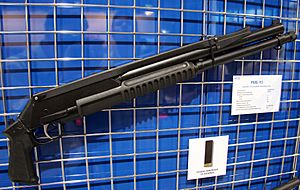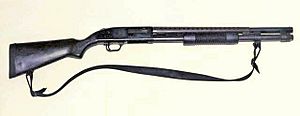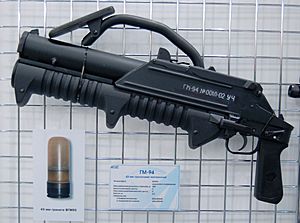Pump action facts for kids
Pump action or slide action is a way that some firearms work. It's a type of gun that you operate by hand. To make it work, you slide a part called the handguard (or forend) that's on the front of the gun.
When you fire a shot, you pull the sliding forend backward. This makes the gun throw out the empty shell and get ready to fire again. Then, you push the forend forward to put a new bullet or shell into the gun's chamber.
Most pump-action guns have a long tube under the barrel where the ammunition is stored. This is called a tubular magazine. However, some pump-action guns use a box magazine that you can take out. Pump-action is most often seen in shotguns, but it's also used in rifles and even grenade launchers.
Because you use your support hand (the one not on the trigger) to slide the forend, a pump-action gun can be fired faster than a bolt-action gun. It's also a bit faster than a lever-action gun. This is because your trigger hand can stay on the trigger while you reload. Also, because the action moves in a straight line, it helps keep the gun steady when you shoot quickly.
Contents
History of Pump Action Guns
The very first patent for a slide action gun was given to Alexander Bain in Britain in 1854. This was a big step in how firearms could be made to shoot more than one round.
Many older pump-action shotguns could fire very fast. This is because they didn't have a special safety feature called a trigger disconnector. This meant if you held the trigger down, the gun would fire a new round as soon as you pumped it. This quick firing method was called a "slamfire". It was often used with shotguns like the M1897 and M1912 during World War I in trench warfare.
Modern pump-action designs are a little slower than semi-automatic shotguns. However, pump-action guns are more flexible. You can use different types of shotshells, including less powerful ones or special kinds. Semi-automatic shotguns need a certain amount of power from each shot to work properly. Pump-action guns don't have this limit.
Also, like all guns that you operate by hand, pump-action guns are usually more reliable. They work better in tough conditions like dirt, sand, or very hot or cold weather. Because of this, for a long time, most shotguns used by the military were pump-action.
How Pump Action Guns Work
A typical pump-action gun gets its ammunition from a tube under the barrel. This tube also helps guide the sliding forend. You load shells one by one into a port on the gun. A small latch holds the shells in the magazine until they are needed. You can also load a shell directly into the firing chamber, and then fill the magazine completely.
The Operating Cycle
Almost all pump-action guns use a back-and-forth motion of the forend to make the gun ready to fire. The forend is connected to the gun's bolt by one or two bars. Two bars are usually better because they make the forces on the bolt even, which helps prevent it from getting stuck.
After you fire a shot, the bolt unlocks, and the forend can move freely. When you pull the forend backward, the bolt moves to the rear. This pulls out and throws away the empty shell. It also cocks the hammer (or firing pin) and starts to get the next shell ready. If the gun has a tubular magazine, one shell is released from the magazine and moves onto a part called the "elevator."
As you push the forend forward, the elevator lifts the shell up, lining it up with the barrel. The bolt then moves forward, pushing the shell into the chamber. The last part of the forend's movement locks the bolt into place. Now, the gun is ready to fire again when you pull the trigger.
Most pump-action guns don't have a way to tell you when they are out of ammunition. So, it's possible to pump the gun and find the chamber empty. To avoid running out of ammo unexpectedly, especially when hunting, people often "top off" the magazine. This means loading new shells to replace the ones that have just been fired.
There was a unique pump-action gun called the BSA Machine Carbine that also required twisting the handguard. Another interesting design was the Burgess Folding Shotgun from the late 1800s. Instead of sliding the forend, you slid a sleeve around the grip area of the stock to cycle the gun. This was done because the forend-based pump action was protected by a patent at the time.
Pump Action Shotguns
Pump-action shotguns are the most common type of pump-action firearm. These shotguns usually have a tubular magazine under the gun barrel to hold the shells. However, some versions use a box magazine, similar to most rifles. It's common to see extra shells stored on the outside of the gun, often on the side of the receiver or on the buttstock, for quick reloading. You load and unload shells by pulling or pushing the sliding fore-end that covers the tubular magazine.
In modern shotguns, the fore-end can often be changed. It might have special rails (like picatinny rails or M-LOK) to attach accessories such as a tactical light. The traditional straight grip might also be replaced with a pistol grip for better control.
Trigger Disconnectors in Shotguns
Modern pump shotguns, like the Remington 870 and Mossberg 500, have a safety feature called a trigger disconnector. This part makes sure that the trigger is disconnected from the firing mechanism when the bolt moves back. This means you have to release the trigger and pull it again to fire the shotgun after it closes.
Many older pump shotguns, such as the Winchester 1897, did not have this feature. If you held the trigger back, they would fire immediately as soon as the action closed. Some shooters prefer models without this feature, like the Ithaca 37 or Winchester Model 12, because it allows for a faster rate of fire.
Pump Action Rifles
When this action is used in rifles, it's also called a slide action or, in the 1800s, a trombone action. The Colt company made the Colt Lightning Carbine from 1884 to 1904. It fired a .44-40 caliber bullet. The slide action Winchester Model 1890 rifle, which fired .22 bullets, was one of the most successful repeating rimfire rifles made by Winchester. About 849,000 Model 1890 rifles were made between 1890 and 1932. Other companies like Marlin, Browning, and Remington also made pump-action rifles later on.
Sometimes, you might find a "reverse pump-action" design. In these guns, you push the fore-end forward to remove the empty shell, and then pull it backward to load a new one. An example of this is the Krieghoff Semprio "in-line repeating rifle" from the 21st century.
Pump Action Airguns
The term pump-action can also describe some airsoft guns and air guns. These often use a similar sliding mechanism to load a pellet and also to compress a spring or air for power. For more information on how these airguns work, you can look at the airgun article.
Pump Action Grenade Launchers
The 43mm GM-94 is a pump-action grenade launcher. It was created by the KBP design bureau for Russian special forces. This launcher holds three rounds in a tubular magazine located above the barrel.
Another pump-action grenade launcher is the China Lake grenade launcher. This one was used in small numbers by the U.S. Navy SEALS during the Vietnam War.
See also
 In Spanish: Acción de bombeo para niños
In Spanish: Acción de bombeo para niños
- List of pump-action rifles
- Remington 7600
Other Long Gun Actions
- Single-shot
- Break-action
- Rolling block
- Falling block
- Repeating
- Revolving
- Bolt-action
- Lever-action
- Self-loading (semi-/fully automatic, select fire)
- Recoil operation
- Blowback
- Blow-forward
- Gas operation





